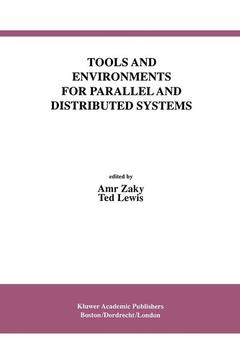Description
Tools and Environments for Parallel and Distributed Systems, 1996
International Series in Software Engineering Series, Vol. 2
Coordinators: Zaky Amr, Lewis Ted
Language: English
Subject for Tools and Environments for Parallel and Distributed Systems:
Publication date: 10-2012
305 p. · 15.5x23.5 cm · Paperback
305 p. · 15.5x23.5 cm · Paperback
Description
/li>Contents
/li>Comment
/li>
Developing correct and efficient software is far more complex for parallel and distributed systems than it is for sequential processors. Some of the reasons for this added complexity are: the lack of a universally acceptable parallel and distributed programming paradigm, the criticality of achieving high performance, and the difficulty of writing correct parallel and distributed programs. These factors collectively influence the current status of parallel and distributed software development tools efforts.
Tools and Environments for Parallel and Distributed Systems addresses the above issues by describing working tools and environments, and gives a solid overview of some of the fundamental research being done worldwide. Topics covered in this collection are: mainstream program development tools, performance prediction tools and studies; debugging tools and research; and nontraditional tools.
Audience: Suitable as a secondary text for graduate level courses in software engineering and parallel and distributed systems, and as a reference for researchers and practitioners in industry.
Tools and Environments for Parallel and Distributed Systems addresses the above issues by describing working tools and environments, and gives a solid overview of some of the fundamental research being done worldwide. Topics covered in this collection are: mainstream program development tools, performance prediction tools and studies; debugging tools and research; and nontraditional tools.
Audience: Suitable as a secondary text for graduate level courses in software engineering and parallel and distributed systems, and as a reference for researchers and practitioners in industry.
Preface. Overview. Part I: Development Tools and Environments - Introduction. 1. A Visual Approach to Distributed Programming; K. Ng, et al. 2. ANNAI: An Integrated Parallel Programming Environment for Multicomputers; C. Clémençon, et al. 3. Bulk Synchronous Parallel Computing - A Paradigm for Transportable Software; T. Cheatham, et al. 4. Performance and Scalability Issues in the Design and Implementation of a Parallel Programming Environment; D. Feldcamp, A. Wagner. Part 2: Performance Prediction and Analysis - Introduction. 5. Performance Prediction of Dynamic Structures with N-MAP; A. Ferscha, J. Johnson. 6. Performance Analysis of Large Scale Parallel Applications; O. Hansen. 7. Efficiency Evaluation of PVM 2.X, PVM 3.X, P4, EXPRESS and LINDA on A Workstation Cluster Using the NAS Parallel Benchmarks; G. Kotsis, F. Sukup. Part 3: Debugging Tools - Introduction. 8. Accommodating Heterogeneity in a Debugger - A Client-Server Approach; R. Hood, D. Cheng. 9. Efficient Detection of Unstable Global Conditions Based on Monotonic Channel Predicates; V. Garg, et al. Part 4: Less Traditional Approaches - Introduction. 10. A Formal Semantics and An Interactive Environment for SISAL; I. Attali, D. Caromel, A. Wendelborn. 11. Parallel High-Performance Matrix Computations in the MaTRiX++ System; T. Collins, J. Browne. 12. Transparent Object Distribution and Remote Inheritance; T. Wolff. Index.
This book describes working tools and environments, and gives a solid overview of some of the fundamental research being done worldwide. Topics covered in this collection are : mainstream program development tools, performance prediction tools and studies , debugging tools and research , and nontraditional tools.
© 2024 LAVOISIER S.A.S.




